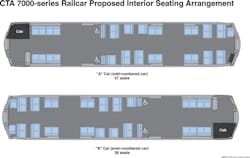As part of a continuing plan to modernize its rail fleet, the CTA announced Aug. 2 it has developed a new, customer-friendly rail car seating configuration for the next generation of rail cars that it plans to purchase and introduce as early as 2016.
The new seating design, created after careful study of existing design, passenger flow, capacity and comfort, is a hybrid of the best features from existing CTA rail car styles—incorporating both forward- and aisle-facing seats. The CTA conducted both empirical research as well as customer surveys to develop a recommended seating configuration.
The proposed configuration for the 7000 series, as the next generation is called, will be provided to manufacturers bidding on the rail car project, which could be up to 846 cars and cost nearly $2 billion. The 7000 series is designed to replace the oldest rail cars in the CTA’s fleet, reducing the average age of the CTA's fleet to around 10 years by 2022. The CTA issued an Invitation for Bids in February 2013 for the rail cars and expects to select a manufacturer by January 2014.
These rail cars, expected to begin delivery around 2016, will replace current rail stock that is nearing or beyond 30 years of age. Replacement of these aging cars will reduce service delays from mechanical breakdowns and save millions of dollars in operating costs.
“Under Mayor Emanuel, the CTA continues its aggressive plan to modernize the nation’s second-largest transit system, which provides more than 1.7 million rides each weekday,” said CTA President Forrest Claypool. “This includes significantly upgrading our bus and rail fleets, replacing aging vehicles, improving passenger comfort and enhancing service reliability. After careful study, the CTA believes the proposed seating design will provide customers with an optimal car that is comfortable, smooth and reliable for passengers, while maximizing passenger flow and capacity.”
In the new design, the front of the car would offer aisle-facing seats to maximize standing space.
The middle of the car would feature an asymmetrical mix of forward-facing and aisle-facing single seats and seat pairs, similar to the configuration found on rail cars used on the brown and orange lines (3200 series cars), which allow for more passengers to stand with ease.
The rear of the car would include rows of forward-facing seat pairs, providing the maximum number of forward-facing seats in area that will not impede passenger flow.
Additional features include two locations per car for passengers with wheelchairs. Also, the rail car configuration could include offset poles and straps for standing passengers on each side of the aisle, instead of poles located directly across the aisle from each other, which increases the chances of passengers standing back-to-back and inadvertently blocking the aisle.
The new design would have as many as 38 seats, compared with 38-46 on other rail cars. The proposed configuration would have a more even mix of forward-facing (53 percent) and aisle-facing (47 percent) seats in a design that promotes more efficiency in boarding and exiting the train while providing passengers several standing and seating choices.
The CTA fleet currently consists of approximately 1,300 rail cars. The new 7000 series cars would replace the CTA’s oldest rail cars, including the approximately 400 2600 series, which were built between 1981 and 1987 by Budd Co. Additional, later-year options could allow for the timely replacement of the 256 cars in the 3200 series, which were built in 1992-93 by Morrison-Knudsen. In addition, the CTA could expand its rail fleet if ridership trends or system expansion warrants.
CTA is currently adding the newest generation of cars, the 5000 series, manufactured by Bombardier, to its fleet. The CTA has added more than 290 of the cars, of a total planned 714 rail cars, on the pink, red and green lines. The 5000 series cars are replacing 2200 series cars manufactured by the Budd Co. in 1969-70, 2400 series cars built by Boeing-Vertol between 1976 and 1978, and a portion of 2600 series cars built by Budd between 1981 and 1986.


